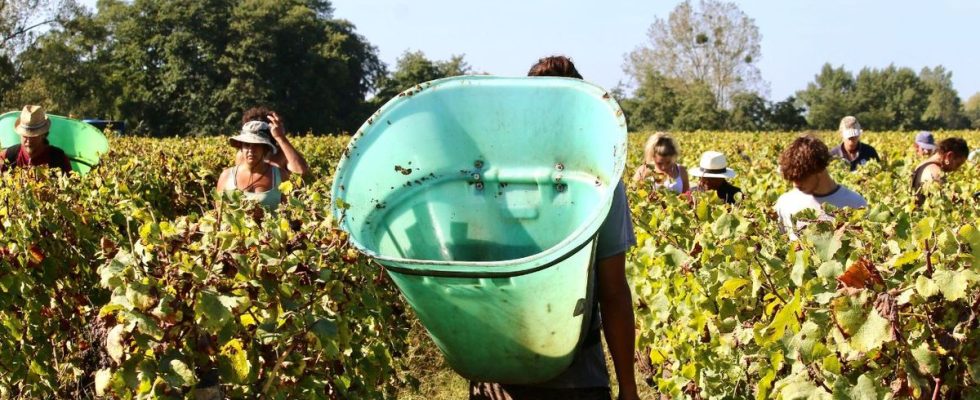This Thursday, the forty grape pickers from Château Rayne-Vigneau, in Bommes to the south of Bordeaux, are already making their second visit to the vineyards. The first collection took place on September 14, the day of the launch of the harvest for this premier grand cru classified in Sauternes. A historically early start this year, in an appellation which usually starts well after everyone else in Bordeaux, and rarely before the beginning of October.
“We are in one of the earliest harvests in the last thirty years,” underlines Vincent Labergère, director of the château. The explanation? The temperatures, “which have been very high this year. » This is still the case on September 28 with a thermometer showing 31°C. On Monday, October 2, the mercury is expected to rise to 34°C…
Botrytis cinerea, feared by all winegrowers, blessed in Sauternes
“The vegetation was not particularly advanced,” explains Vincent Labergère, “on the other hand we are experiencing a phenomenon of concentration of grapes, called raisining, which results in grapes that dry out. For our first grand cru, we must remove all these raisined grapes from the vines, leaving only the botrytized grapes which will be used to make the great wine. This therefore represents an additional passage through the ranks, which explains why we started earlier. »
Sauternes is a very small appellation of 1,800 hectares located about forty km south of Bordeaux. To produce the famous sweet white wine renowned throughout the world, a microscopic fungus called the grape must be allowed to develop on the grapes. botrytis cinerea, or noble rot. “It is a fungus feared by all winegrowers, since it damages the grapes, except in Sauternes where it ennobles them, thanks in particular to the terroir. The grape has the capacity to respond to aggression from botrytis, giving something extraordinary and inimitable. »

The appellation, which covers five communes, concentrates eighteen great classified growths, or 50% of the properties, and produces “less than four million bottles per year. » “We are in a little gem, it’s goldsmith’s work. »
Change in viticultural practices
While each area has its own specificities, the precocity of the harvest this year affects almost everyone. What impact will this have on this prestigious white wine? “This in no way impacts the quality of the vintage,” insists Vincent Labergère, “on the other hand, it changes our relationship to botrytis. Thirty years ago, we made sure that the grapes were ripe first, and that botrytis arrived later, because in September it was 20°C maximum, and in October 15°C. Today, with 30°C or more, we have completely reversed the way we work. We have adapted to this climate change. From now on, we support the development of botrytis : before, we removed more leaves, to properly clear the grapes and prepare for the arrival of the botrytis, now we leave leaves, grass, we try to capture a little more dew… We also prune much later, compared to even five years ago. It’s another job. »

THE botrytis also develops thanks to the fog banks which are created at the end of summer, the meeting between the small Ciron river and its water thermoregulated at 14°C all year round, and the Garonne, much warmer . “These banks of fog rise over the Sauternes appellation, which generates this famous humidity which allows the fungus to develop,” explains Vincent Labergère. In the afternoon, the fog dissipates, the fungus stops its development, and it is this precarious balance which favors the ennoblement of the grapes by the botrytis. Today, the temperatures mean that this fog disappears much more quickly, which means that we work differently when sorting the grapes. Before, we needed a smaller team, because we were moving slowly, now we have to go very quickly because the interesting windows for sorting are tighter. »
“Thirty years ago, there was a kind of climatic eternity”
When did the situation change? Difficult to say, “even if we all keep in mind 2003, which was a scorching year” recalls Vincent Labergère. “But since then, there have been back and forths, between more or less warm years. What is certain is that for several years we have repeatedly had this problem with vines which starts very early, because it is hot very early in the year, and this phenomenon is accelerating. »
Faced with this acceleration, “we must adapt our viticulture. » In the short term, this means changing practices, “in the long term it will certainly be the plant material: changing the rootstocks, perhaps even the grape varieties. » “When I started thirty years ago there was a kind of climatic eternity, I had absolute certainty in what I had to choose as plant material,” continues the director, “now there is a level of very strong uncertainty, because I am unable to project myself into even fifteen years. But the vine is a Mediterranean plant which has this ability to adapt anywhere, it is incredibly resilient. »
How far is the big question. Even if Vincent Labergère does not want to be alarmist, he recognizes that “we are on an evolution which is difficult to quantify for the years to come. »

